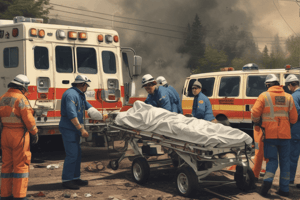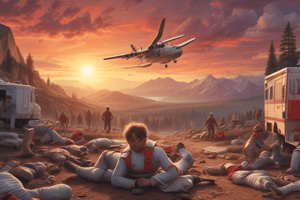Podcast
Questions and Answers
Which triage category would a 36-year-old male who is unresponsive with brain matter showing fall under?
Which triage category would a 36-year-old male who is unresponsive with brain matter showing fall under?
- Yellow
- Red
- Green
- Black (correct)
What triage category would a 50-year-old patient with bilateral fractured femurs, faint radial pulse, and respiratory rate of 24 most likely be assigned to?
What triage category would a 50-year-old patient with bilateral fractured femurs, faint radial pulse, and respiratory rate of 24 most likely be assigned to?
- Yellow
- Black
- Red (correct)
- Green
In a triage scenario, which category does a 16-year-old female who is ambulatory and verbally responsive to questions typically belong to?
In a triage scenario, which category does a 16-year-old female who is ambulatory and verbally responsive to questions typically belong to?
- Red
- Yellow
- Green (correct)
- Black
A 66-year-old male sitting on the grass, unable to answer or follow directions, would most likely be categorized as?
A 66-year-old male sitting on the grass, unable to answer or follow directions, would most likely be categorized as?
Which category does a 19-year-old male with extensive burns over 80% of his body, along with rapid breathing and elevated pulse, belong to?
Which category does a 19-year-old male with extensive burns over 80% of his body, along with rapid breathing and elevated pulse, belong to?
An unresponsive male patient with snoring respirations that improve when the airway is opened would be classified as?
An unresponsive male patient with snoring respirations that improve when the airway is opened would be classified as?
Which triage category would a conscious but pale, moist-skinned female with very slow respiration rate be placed in?
Which triage category would a conscious but pale, moist-skinned female with very slow respiration rate be placed in?
A 42-year-old woman with no obvious injuries and without a carotid pulse would likely be categorized as?
A 42-year-old woman with no obvious injuries and without a carotid pulse would likely be categorized as?
What triage category does a responsive male with a broken arm walking around the road fit into?
What triage category does a responsive male with a broken arm walking around the road fit into?
In a triage setting, which category would a 36-year-old male with an unresponsive state and brain matter showing be assigned to?
In a triage setting, which category would a 36-year-old male with an unresponsive state and brain matter showing be assigned to?
What triage category would a responsive 34-year-old female with pale, moist skin and respiration of 3/min be classified under?
What triage category would a responsive 34-year-old female with pale, moist skin and respiration of 3/min be classified under?
Which triage category would a 57-year-old female with a deformed tibia, oriented, respiration of 20, and pulse of about 100 fall under?
Which triage category would a 57-year-old female with a deformed tibia, oriented, respiration of 20, and pulse of about 100 fall under?
What category does an unresponsive male patient with snoring respirations that improve when the airway is opened belong to in triage?
What category does an unresponsive male patient with snoring respirations that improve when the airway is opened belong to in triage?
Where would a 50-year-old patient with bilateral fractured femurs, faint radial pulse, and respiratory rate of 24 most likely be assigned in a triage situation?
Where would a 50-year-old patient with bilateral fractured femurs, faint radial pulse, and respiratory rate of 24 most likely be assigned in a triage situation?
Which category is typically assigned to a 14-year-old male with a broken arm walking around the road during triage?
Which category is typically assigned to a 14-year-old male with a broken arm walking around the road during triage?
A 66-year-old male patient sitting on the grass, unable to answer or follow directions, would most likely be categorized as?
A 66-year-old male patient sitting on the grass, unable to answer or follow directions, would most likely be categorized as?
Which triage category is appropriate for a 42-year-old woman with no obvious injuries and without a carotid pulse?
Which triage category is appropriate for a 42-year-old woman with no obvious injuries and without a carotid pulse?
What category would a 19-year-old male with second and third degree burns over 80% of his body, respirations of 24, and pulse about 120 belong to in a triage situation?
What category would a 19-year-old male with second and third degree burns over 80% of his body, respirations of 24, and pulse about 120 belong to in a triage situation?
What domains are considered when planning for special events, mass gatherings, and mass casualty incidents?
What domains are considered when planning for special events, mass gatherings, and mass casualty incidents?
How does the text suggest responding to extraordinary events during mass gatherings?
How does the text suggest responding to extraordinary events during mass gatherings?
What is a key goal of emergency care at mass gatherings according to the text?
What is a key goal of emergency care at mass gatherings according to the text?
In a crowd density scenario, what negative behaviors can be incited among individuals attending large events?
In a crowd density scenario, what negative behaviors can be incited among individuals attending large events?
Which factor is crucial in managing mass gatherings in disaster situations?
Which factor is crucial in managing mass gatherings in disaster situations?
What is a key principle for the Incident Command System (ICS) to operate adequately during large events?
What is a key principle for the Incident Command System (ICS) to operate adequately during large events?
Which critical function is NOT part of the JCAHO's list for managing internal disasters within hospitals and healthcare settings?
Which critical function is NOT part of the JCAHO's list for managing internal disasters within hospitals and healthcare settings?
In a mass gathering disaster situation in a megacity with over 10 million population, which factor would increase the vulnerability of the crowd to environmental hazards?
In a mass gathering disaster situation in a megacity with over 10 million population, which factor would increase the vulnerability of the crowd to environmental hazards?
During which phase of a hospital's internal disaster response plan are nonessential services typically suspended?
During which phase of a hospital's internal disaster response plan are nonessential services typically suspended?
Which scenario is an example of an altitude-related condition that may occur during a disaster within a healthcare setting?
Which scenario is an example of an altitude-related condition that may occur during a disaster within a healthcare setting?
Flashcards
Triage System
Triage System
A triage system in which patients are categorized based on severity of injury or illness. Black denotes Deceased or Expected Death, Red denotes Immediate Care, Yellow denotes Can Wait, Green denotes Minimal Care.
Black Triage
Black Triage
A triage category in which patients are assessed as deceased or expected to die despite medical intervention.
Red Triage
Red Triage
A triage category for patients with the most critical and life-threatening injuries or conditions requiring immediate medical attention.
Green Triage
Green Triage
Signup and view all the flashcards
Yellow Triage
Yellow Triage
Signup and view all the flashcards
Patient in Black Triage
Patient in Black Triage
Signup and view all the flashcards
Patient in Red Triage
Patient in Red Triage
Signup and view all the flashcards
Patient in Green Triage
Patient in Green Triage
Signup and view all the flashcards
Patient in Yellow Triage
Patient in Yellow Triage
Signup and view all the flashcards
Patient in Red Triage
Patient in Red Triage
Signup and view all the flashcards
Patient in Yellow Triage
Patient in Yellow Triage
Signup and view all the flashcards
Patient in Black Triage
Patient in Black Triage
Signup and view all the flashcards
Patient in Black Triage
Patient in Black Triage
Signup and view all the flashcards
Patient in Green Triage
Patient in Green Triage
Signup and view all the flashcards
Patient in Black Triage
Patient in Black Triage
Signup and view all the flashcards
Patient in Black Triage
Patient in Black Triage
Signup and view all the flashcards
Patient in Red Triage
Patient in Red Triage
Signup and view all the flashcards
Patient in Yellow Triage
Patient in Yellow Triage
Signup and view all the flashcards
Patient in Red Triage
Patient in Red Triage
Signup and view all the flashcards
Patient in Green Triage
Patient in Green Triage
Signup and view all the flashcards
Patient in Yellow Triage
Patient in Yellow Triage
Signup and view all the flashcards
Patient in Black Triage
Patient in Black Triage
Signup and view all the flashcards
Patient in Red Triage
Patient in Red Triage
Signup and view all the flashcards
Event Planning Domains
Event Planning Domains
Signup and view all the flashcards
NIMS for Mass Gatherings
NIMS for Mass Gatherings
Signup and view all the flashcards
Emergency Care at Mass Gatherings
Emergency Care at Mass Gatherings
Signup and view all the flashcards
Crowd Density Effects
Crowd Density Effects
Signup and view all the flashcards
Medical Aid Station Placement
Medical Aid Station Placement
Signup and view all the flashcards
ICS Terminology
ICS Terminology
Signup and view all the flashcards
JCAHO Disaster Response
JCAHO Disaster Response
Signup and view all the flashcards
Mass Gathering Vulnerability
Mass Gathering Vulnerability
Signup and view all the flashcards
Hospital Disaster Response Phases
Hospital Disaster Response Phases
Signup and view all the flashcards
Altitude-Related Condition
Altitude-Related Condition
Signup and view all the flashcards




